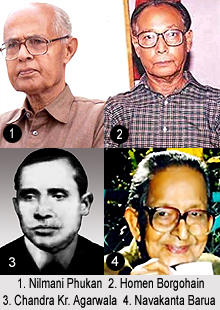 Modern Poets of Assam thrives to decipher the contemporary strings of modernity which had been an annulment of real life of the people. Assamese poetry of the forties registered a fresh departure which was visible in technique and subject-matter of Assamese contemporary poetry. Political and social absorption was a new resurgence in Assamese Poetry that drew poets away from the world of romantic dreams into the world of realism. This new trend in Assamese literature made its appearance during the forties of this century under the patronage of a journal called Jayanti Era. This poetry was critical, socially conscious and anarchic in technique and subject-matter.
Modern Poets of Assam thrives to decipher the contemporary strings of modernity which had been an annulment of real life of the people. Assamese poetry of the forties registered a fresh departure which was visible in technique and subject-matter of Assamese contemporary poetry. Political and social absorption was a new resurgence in Assamese Poetry that drew poets away from the world of romantic dreams into the world of realism. This new trend in Assamese literature made its appearance during the forties of this century under the patronage of a journal called Jayanti Era. This poetry was critical, socially conscious and anarchic in technique and subject-matter.
Assamese Poets after the European Influence in actuality crafted the poetic map of Assam anew afresh. Burdened with the complexity of the lives one leads, fretting over appearances, netted in with anxieties and apprehensions, half smothered in drift of tepid thoughts and tepid feelings, one may refuse what poetry has to give; but under its influence serenity returns to the troubled mind, the world crumbles, loveliness shines like flowers after rain and the further reality is once more charged with mystery. Assamese Poetry had the same to offer.
Navakanta Barua has also established his reputation as a promising poet of the age. Navakanta`s three published books of verse are He Aranya, He Mahanagar (O Forest, O Metropolis) Eti Duti Egharati Tara (Counting up eleven stars) and Yati. Navakanta has been influenced more deeply by T. S. Eliot than by others. Like Eliot he also believes that poetry requires a language distinct from that of prose, a language rich in suggestions both to the senses and the intellect. Naturally, Navakanta`s poetry tends to become difficult. In this respect, the Assamese poet also holds that poets in our complex civilisation must be difficult.
Birendrakumar Bhattacharya has also rallied round the left wing banner, and his poetry is pungent criticism of the present day social order. He is the editor of the monthly magazine, Ramdhenu (The Rainbow), round which all new poets gather as members of a family. Ramdhenu has created not only a congenial atmosphere for new poetry but also a growing circle of admirers for it. Obscurity, shocking images and a good deal of literary allusions are the notable features of the poems of Hari Barkakati and Mahendra Bora. Both of them are considered to be intellectuals, and they register in their writings impressions mostly of modern life with emphasis on cosmopolitan elements.
Mahendra Bora has recently compiled a selection from the writings of twenty young poets and calls it Natun Kavita (New poetry). The sixty-eight short poems in Natun Kavita of varied contents and metres reveal to what extent these new poets have freed themselves from the bondage of traditional themes, verse-patterns, techniques and taboos. Homen Bargohain writes short stories and poetry with equal felicity and distinction. His poetry dwells mostly on sex themes and Bargohain`s fondness for sex imagery is reminiscent of the poetry of Dylan Thomas.
The other younger poets Dinesh Goswami, Nilmani Phukan (Junior), Bireswar Barua, Mahim Bora have used novelty of ; themes, new symbolism and imagery, and have thus generated scepticism and a high pitch of social consciousness in their poetry.
Chandrakumar Agarwala`s breathes a love of beauty, a joy in living and a spirit of optimism, issuing forth from a warm, sympathetic and tender heart. He did not follow the beaten track, and in his poetry there are some new trends. While older poets believed beauty to dwell in the ambrosial bliss of the heaven of the hereafter modern poets discover the same beauty in the heart of Nature. Chandrakumar went a step further and maintained that it dwells in man`s tender affection, cordiality and grace. Pratima (The Image) is a small collection containing beautiful nature poems such as Sandhya (The Evening), Prakrti (Nature), Niyar (The Dew), etc., in which the poet gives glowing pictures of Nature`s mysterious and awe-inspiring beauty and conveys the profound appeal that she makes to the mind of man. Romanticism, under whose wings he had come during his younger days, also directed his thought to folklore. His Ban-kumvari (The Wood-land Nymph), Jal-kumvari (The Sea Nymph), Tejimala (The Creeper Nymph) and other such poems are pregnant with a supernatural beauty and mystery.
Ananda Chandra Agarwala (1874-1940) translated poems from English which read like the original. He also wrote several narrative poems of absorbing interest based on folktales. Hiteswar Barbarua (1876-1939) wrote long narrative poems in blank verse and a number of sonnets, modelled after English types. His earliest collection, Dhopakali (The Bud, 1902), contains poems composed in early youth. The long poem, Kamatapur Dhvamsa aru Birahini Bilap Kavya (The Fall of Kamatapur and the Sorrows of Parted Lovers), was published in 1912. The theme is taken from mediaeval Assamese history. It describes how ancient Kamatapur (situated near modem Cooch Behar) was sacked, during the reign of King Nilambar by the Nawab of Gaur through the conspiracy of Nilambar`s -own minister. Divided in fifteen sections, the poem is mostly dramatic.



















